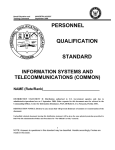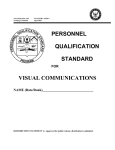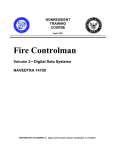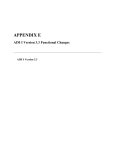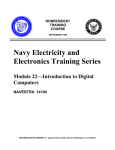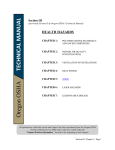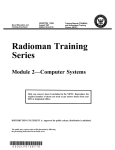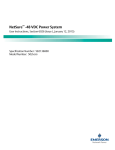Download AIM II v3.3 (Lesson/Section) Release Notes
Transcript
AIM II v3.3 (Lesson/Section) Release Notes This document is intended as a quick start guide to installing AIM II v3.3 (Lesson/Section). You should read this entire document before proceeding with the installation. It also details some general information about the program that did not make it into the User’s Manual. If you need help with the installation or use of AIM, you should contact the System Support Office (SSO). Contact information can be found in the User’s Manual. Information on how to use and create Lessons and Sections can be found under the Help menu on the AIM Main screen, titled E-LINC and Lesson/Section. Warnings AIM II v3.3 output is not backward compatible with AIM II v3.2.1, i.e. you cannot export a Course from v3.3 and import it into v3.2.1. As such, if you plan on creating/editing Courses in AIM and passing them to other users, you either need to perform this in AIM II v3.2.1, or make sure all users getting your content is also running AIM II v3.3. Installation Quick-Start Before you install AIM, you should: 1. Make sure there is a recent backup of your existing AIM database (if you already have a version of AIM installed). 2. If you are planning on installing AIM II v3.3 into your AIM II v3.2.1 directory, consider uninstalling AIM II v3.2.1 first. This is not required, but it will remove any files from your system that are no longer needed by AIM II v3.3. To uninstall AIM II v3.2.1, go to your Start Menu, choose Settings, and then choose Control Panel. When it opens, double-click Add/Remove Programs. Highlight AIM II v3.2.1 in the list, and click the Add/Remove button. Note: Uninstalling AIM II v3.2.1 will NOT delete your existing database files. 3. Write down the location of the AIM directory on the network, if you run AIM from a server (not installed on your local machine). 4. Write down the location of the directory containing the existing AIM database, as well as the name of the associated Graphics directory, if any. If you do not have an existing database, determine where you want to place it (on the network or on your local machine). Warning: If you are installing AIM II v3.3 separately from a previous version, you will need to make a copy of your existing Database directory to use with v3.3. If you select your existing v3.2.1 database to be used with v3.3, AIM will convert it to v3.3 format, and it will no longer work with the v3.2.1 software. To install AIM II v3.3, follow these steps: 1. Insert the AIM II v3.3 installation CD into your CD-ROM drive of your computer. 2. If the AIM II v3.3 installer does not start up automatically, double-click the My Computer icon on the desktop, double-click the CD drive icon, and finally double-click the Setup.exe icon (if your system does not display extensions of files, then the file will be called just Setup). Note: Depending on what operating system and software that is already installed on your computer, the installation program may prompt you to reboot your computer one or more times before the Page 1 of 4 AIM II v3.3 Installation Guide and Release Notes installation program actually runs. This is normal, as it is installing certain key system files required for it to run correctly. 3. Click the Next button to navigate past the Introduction screen. 4. The next screen displays the Read Me file for the installer. Make sure you read it through before continuing. 5. The next screen displays the Customer Information screen. You can enter your Name and Company into the appropriate fields. If you are installing AIM as an administrator on Windows NT or 2000, you will also see an option to install it for all users or just the current user. Choose All Users if you want any user to be able to use the software. 6. The next screen will prompt you for the directory to install the AIM software. Click the Change button to select another directory. If AIM will be run from a network server, select the directory where the AIM software is located. Then click Next. 7. Finally you need to select which type of installation you want to perform. There are three options: • Typical: Choose this option if you are updating AIM, installing AIM on your local drive, or installing it on a server for others to use. This will install all the required elements for AIM to run. • Minimal: Choose this option if you are planning on running AIM from a server. This will install on your local machine just the software needed to run an existing copy of AIM II v3.3 already installed on a network directory. • Custom: Choose this option if you want to install some of the optional components, for example, the NAVEDTRA 131A manuals in PDF format. 8. Once you’ve made a selection, click on Next. If you chose the Custom option, you will now be displayed a list of AIM components to install. Make your selections, then click Next one last time. 9. Finally, you’ve reached the installation summary screen. This summarizes your selections from the previous screens. If you want to change any selection, click Back. If all the settings seem correct, click on Finish. The installation will now commence. When it is finished, it may ask you to reboot your computer one last time. Once installed, you can run AIM by double-clicking the icon on the desktop, or by going to the Start Menu and choosing Programs->AIM II->AIM II. Installation Comments: • AIM has been tested under Windows 95/98/Me, NT 4.0 Workstation, and Windows 2000/XP. If you are running Windows NT 4.0, you should be running at least Service Pack 4 (SP 6a is recommended). If you are running Windows 2000, you should install Service Pack 1. • AIM requires Microsoft Internet Explorer 4.0 or higher installed. • The new IMI (Interactive Multimedia Instruction) features of AIM require Windows Media Player 6.4 or higher installed. All versions of Windows, except some installations of Windows 95 and NT, come with Windows Media Player installed. Known Issues: • Due to the installation of several system files, Windows NT/2000/XP users will need administrative rights to the local machine in order to install AIM II v3.3. • AIM installs some files using long filenames (not DOS-like 8.3 names). Therefore, you may experience problems installing AIM onto older servers that do not support long file names. • Due to the way AIM now works, you cannot install multiple copies of AIM II v3.3 on one system. However, you can make a copy of the AIM directory, delete the AIM.INI file, and choose another database to use as your AIM database (this can be done so you have AIM icons for a local database and a networked database). • Even if you do keep two AIM directories on one system, when you launch an AIM module (like LP or Admin), it will be launched from the directory in which AIM was originally installed. Therefore, if you Page 2 of 4 AIM II v3.3 Installation Guide and Release Notes try to put product updates into the copied directory, the updated software will not be used. It will need to be installed in the original directory. Running AIM for the First Time The first time you run AIM II v3.3, AIM will perform the following actions: 1. If you used the Minimal option when you installed AIM, it will set up AIM to allow it to run from the server. 2. If no AIM.INI file exists in the AIM directory, you will be prompted to specify the database, graphics and media directories. If you already have an existing database, enter the path to that directory. If you do not have an existing database, enter the path where you would want to create one (or leave the default settings as is). If the directory you specify does not contain an AIM database, one will be created for you. Note: The installer will never overwrite an existing database with a new one. 3. If you have a previous installation of AIM II, you will be prompted for the location of a new Media directory. This directory is where AIM will store the files associated with the IMIs. 4. If the database needs to be converted to the latest version of AIM, you will be stepped through the process of converting it to v3.3 format. Note: You will need to have permissions to create and delete files to both the AIM and database directories in order to convert the database. If you do not have these permissions, see your Network Administrator. Warning: Once you’ve converted your database to v3.3 format, it can no longer be used with any previous versions of AIM. If you still want to use a previous version of AIM, you will need to make a copy of your AIM database directory and select that new directory when setting up the database. 5. If you have Microsoft Word installed on your machine, you will be prompted to enable macros in Word. AIM uses Word macros to allow you to add graphics to your Sheets from the AIM Graphics library. a. If you have Word 97 and have Macro Virus Protection turned on in Word’s Options screen, you will be prompted to turn this off. You do not have to disable this option. However, every time you open part of the TG in Word, you will be prompted to enable macros in the document. b. If you have Word 2000, you will be prompted to accept the digital certificate attached to the macros. The macros used by AIM are signed to verify the author of the macros. If you accept the certificate (by checking the “Always trust macros from this source” box), Word will not prompt you about macros in AIM documents. Once these are done, the AIM login screen will display. AIM Comments: • The AIM documentation is in Adobe Acrobat format. • The Help menu on the main AIM screen allows access to the On-line help as well as PDF versions of the AIM User’s manual, a list of changes made to AIM II v3.3, a short how-to on using the new interface implemented in this release, and a set of Frequently Asked Questions. • If at any time you want to connect to a different database, just exit AIM and delete your AIM.INI file. The next time you run AIM, it will notice that the AIM.INI is missing and again step you through selecting a database directory. Page 3 of 4 AIM II v3.3 Installation Guide and Release Notes • AIM now supports use of SQL Server 7 or 2000 as the database engine. SQL Server offers better stability and scalability than the Microsoft Access database engine used by AIM. If you want to upgrade your AIM database to SQL Server, read the file AIM II v3.3 SQL Server Migration.pdf found on the installation CD. Known Issues: • If you’re using Word for editing TG Sheets, and the AIM Graphic or IMI buttons (or associated menu items under the Insert menu) within Word cause errors to appear, you may need to update Office with the latest Service Packs. These can be found on the installation CD. If you do not have permission to install the updates, changing your security setting to Medium or Low should also work. To change your security settings, open Word and go to the Tools->Macros->Security menu. Warning: Before updating Office 2000 with a Service Pack, you MUST have the Word/Office 2000 installation CDs used to install Office on your computer. The Service Packs require these CDs during the installation. If you try to install the Service Packs without the CDs, your installation of Word/Office may become unusable. • • • • • • If you’re using Word 97, make sure you have the Office 97 Service Pack 1 installed. You can check the version of Word installed by choosing About Microsoft Word from the Help menu. AIM does not support versions of Microsoft Word prior to Word 97. Under Windows 95/98, if your computer’s default printer is a Postscript printer, and you enter styled text in a DP or RIA, it will not print. Current work-around is to print with a non-Postscript printer. The Graphics module cannot accept all types of GIF graphics, although some versions of the file format do work. If you have a GIF graphic that AIM cannot read, try saving it in another format (JPG, for example) and then import it into AIM. If you add a graphic while on a line formatted with Bullets and Numbering option, the added graphic entry will be formatted with the same style. To work around this, remove the style from the insertion point before adding the graphic. For spell checking in the HighEditor, the option “Check words in user file” in the Spell Check Options dialog should be turned OFF. The text of this option is unclear. It does not tell the spell check to check the user dictionary, which is handled simply by having the user dictionary, HSPELL.HUE, listed in the list at the top of the dialog. This option pertains to using the Auto-Correction feature of the spell check. Turning this option on can cause some text to disappear during a spell check operation, or, in the worst case, cause the program to freeze. Page 4 of 4






